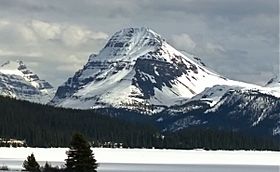Bow Peak facts for kids
Quick facts for kids Bow Peak |
|
|---|---|

Bow Peak reflected in Bow Lake
|
|
| Highest point | |
| Elevation | 2,840 m (9,320 ft) |
| Prominence | 493 m (1,617 ft) |
| Parent peak | Crowfoot Mountain (3055 m) |
| Listing | Mountains of Alberta |
| Geography | |
| Location | Banff National Park, Alberta, Canada |
| Parent range | Canadian Rockies |
| Topo map | NTS 82N09 |
| Geology | |
| Age of rock | Cambrian |
| Type of rock | Sedimentary rock |
| Climbing | |
| Easiest route | Scramble |
Bow Peak is a tall mountain in Banff National Park, Alberta, Canada. It stands 2,840-metre (9,320-foot) high in the Bow River valley. This peak is part of the Canadian Rockies.
The closest higher mountain is Crowfoot Mountain. It is about 2.11 km (1.31 mi) to the east. Bow Peak is located north of Hector Lake and southeast of Bow Lake. You can easily see it from the Icefields Parkway. Even though it's not the highest peak, it's a very noticeable landmark. You can spot it from as far away as the Lake Louise area. Being in the Waputik Mountains means the views from its top are amazing!
Learning About Bow Peak's Name
Why is it called Bow Peak?
Bow Peak got its name in 1922. It is very close to where the Bow River begins. The Cree people called this river "The place from which bows are taken." This is because they used to find wood there to make bows. The mountain's name became official in 1924. This was decided by the Geographical Names Board of Canada.
How Bow Peak Was Formed
Understanding the Rocks of Bow Peak
Like other mountains in Banff National Park, Bow Peak is made of sedimentary rock. This type of rock forms from layers of sand, mud, and tiny bits of sea creatures. These layers were laid down a very long time ago. This happened during the Precambrian to Jurassic periods.
How Mountains Are Built
These rocks formed in shallow seas. Later, powerful forces pushed them up and to the east. This movement caused the older sedimentary rock to slide over younger rock. This process is called the Laramide orogeny. It helped create the huge mountains we see today.
Weather Around Bow Peak
What is the Climate Like?
Bow Peak has a subarctic climate. This means it has very cold, snowy winters. The summers are usually mild. Temperatures can drop below −20 °C. With the wind, it can feel even colder, sometimes below −30 °C.
Where Does the Water Go?
Snow and ice on Bow Peak melt when it gets warmer. This water then flows into the Bow River. The Bow River is a tributary of the larger Saskatchewan River.
Images for kids





